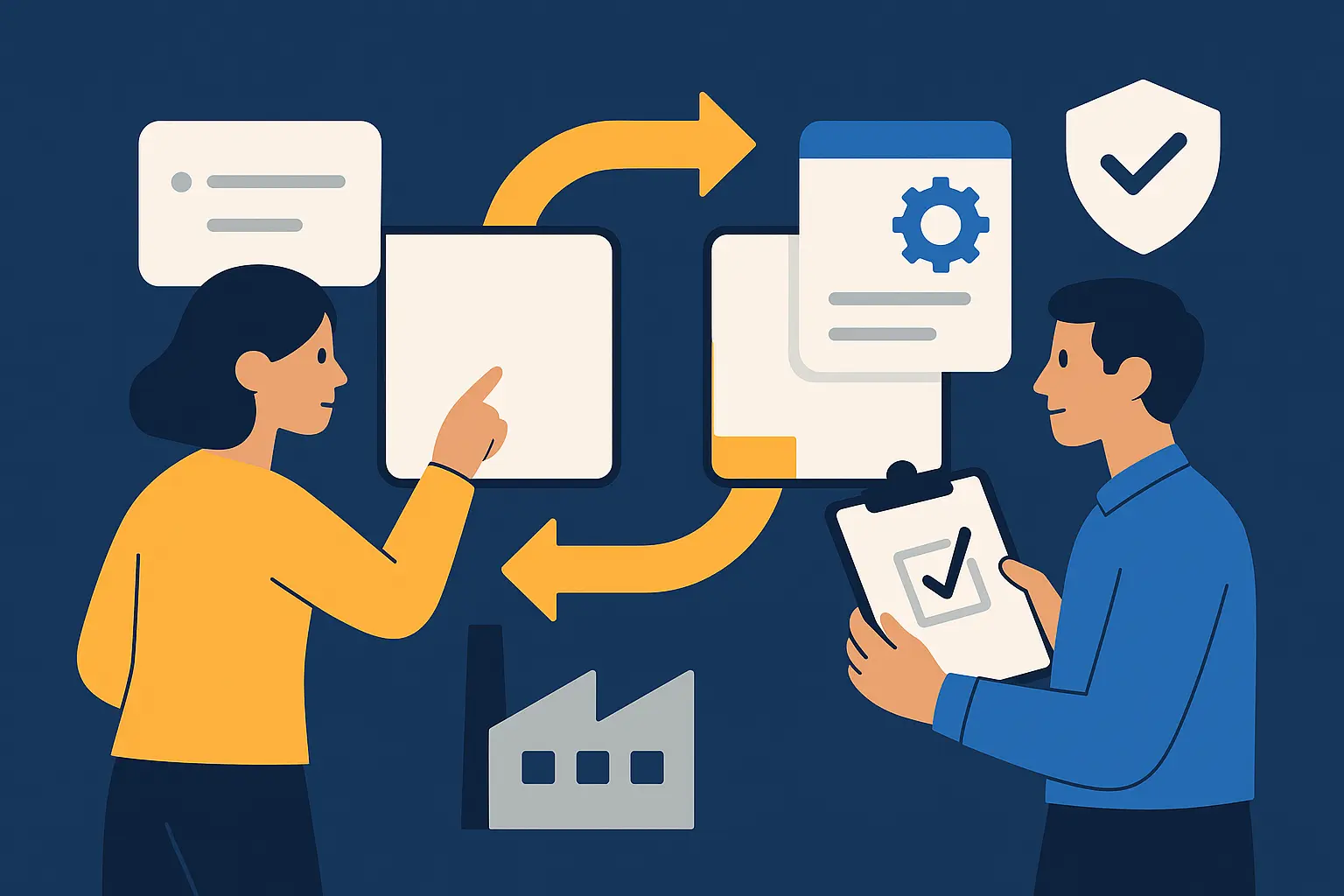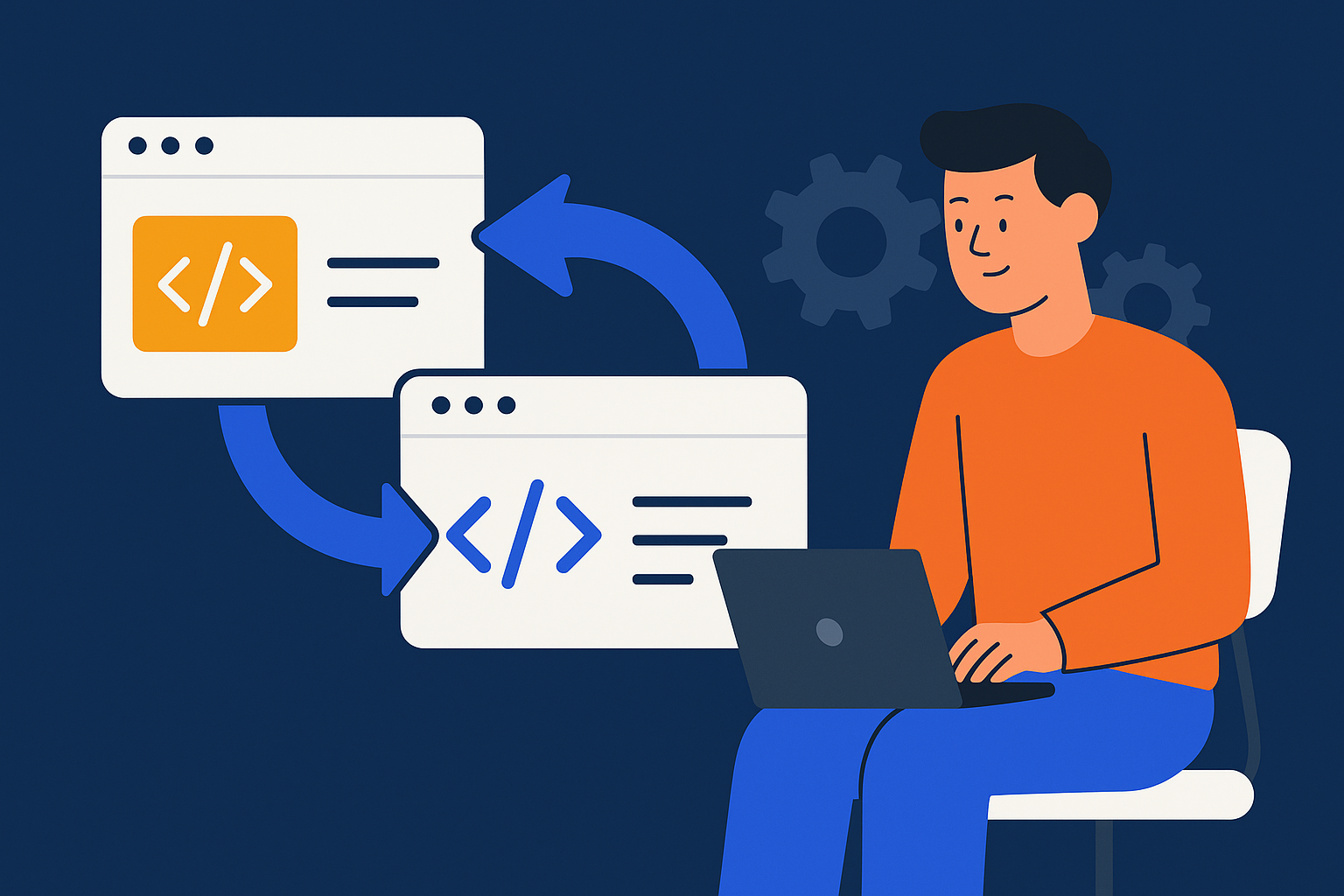Introduction

Pilots and proofs of concept are easy to love: quick, focused, and full of promise. But for many leadership teams, the real challenge starts when that promising MVP needs to meet enterprise reality—procurement, infosec, compliance, data governance, SLAs, and change management. That’s where timelines slip and budgets expand.
This post outlines a senior-friendly blueprint for taking pilots to production inside regulated organizations (financial services, healthcare, insurance, energy, and public sector). It’s designed for C‑level executives, product leaders, founders, and marketing directors who must balance speed with control—without compromising the business case.
Whether you’re engaging a custom web app development agency or aligning internal teams, use this guide to de‑risk delivery, secure compliance sign‑off, and preserve momentum from MVP to enterprise rollout.
The pilot-to-production gap: why MVPs stall

Enterprise MVPs typically stall for a handful of repeatable reasons:
- Security and compliance are addressed too late, forcing rework on identity, data flows, and hosting choices.
- MVP infrastructure can’t scale or lacks parity with production (no IaC, no isolated environments, weak observability).
- Integration complexity is underestimated—especially where legacy systems, vendor APIs, or data residency apply.
- Procurement needs proof (policies, attestations, ownership), but the documentation isn’t production‑grade.
- Roles and runbooks are unclear; there is no agreed operating model or service levels post‑launch.
The result: change requests, duplicated work, strained credibility, and slowed adoption.
A better target condition
A good MVP for an enterprise is not a throwaway demo. It’s a “pilot‑ready product slice” with the hard, non‑functional parts paved early: identity, logging, audit, data protection, and deployment discipline. Done right, the path from pilot to production becomes an expansion—not a rewrite.
What “business‑ready” looks like on day zero
Think in two tracks: “functional value” and “control value.” The first wins users. The second earns approvals.
Non‑functional controls you can’t bolt on later
- Identity and access: SSO via your IdP (SAML/OIDC), role‑based access control, and least privilege by default.
- Data protection: encryption at rest/in transit, key management, secrets rotation, and DLP for sensitive fields.
- Audit and traceability: structured audit logs for user and admin actions; immutable retention aligned with policy.
- Observability: centralized logging, metrics, and tracing with alerting tied to user‑visible symptoms.
- Configuration and IaC: reproducible environments (dev/stage/prod) and policy‑as‑code for baseline security.
- Multi‑tenant boundaries (if applicable): tenant isolation strategy, data partitioning, and noisy‑neighbor controls.
- Release safety: feature flags, blue/green or canary deployments, automated rollbacks.
The procurement packet
Prepare a standard “packet” that answers infosec and procurement on the first pass:
- Architecture diagrams: data flows, trust boundaries, third‑party services.
- Data inventory: classification, residency, retention, and lawful basis for processing.
- Security program overview: policies, secure SDLC, vulnerability management, incident response.
- Compliance mapping: how controls align to frameworks (e.g., SOC 2, ISO 27001, HIPAA where applicable).
- Third‑party due diligence: subprocessors, SLAs, and DPAs.
- Business continuity: RTO/RPO targets, backup strategy, and disaster recovery plan.
- Support and ownership: who runs what (internal vs. partner), escalation paths, and release cadence.
Build these artifacts alongside the product—not after. It reduces review cycles and builds trust.
The minimum viable integration plan
Most pilots fail to consider the “last mile” of integration. A lean but realistic plan includes:
- Source of truth: which system owns customer, policy, or patient data? Define read/write boundaries explicitly.
- Integration styles: event-driven vs. batch; synchronous vs. asynchronous calls; retry and idempotency patterns.
- Error contracts: how you handle partial failures and degraded modes (and how users are informed).
- Secrets and connectivity: managed identity, private endpoints, IP allowlists, and rotations by environment.
- Data synchronization windows: service level for freshness and catch‑up behavior after outages.
Document trade‑offs that keep the pilot fast while preserving a clean migration path.
Operational readiness: SLOs, runbooks, and roles
Operational quality is a product feature—treat it as such.
- SLOs and error budgets: define user‑centric SLOs (e.g., 99.9% availability, p95 response time) and agree on error budgets to guide release risk.
- Runbooks: incident diagnosis steps, common remediations, severity matrix, and comms templates for stakeholders.
- Change control: clear change windows, deployment checklists, and rollback criteria.
- On‑call model: who is on point (internal, partner, or shared)? What are handoff rules and escalation paths?
- Cost guardrails: tag everything; monitor spend by environment and feature to avoid surprises post‑scale.
Value assurance: make ROI measurable, not theoretical
Before expanding beyond pilot, define and baseline a small set of leading indicators tied to your business case:
- Acquisition and activation: time‑to‑first‑value, pilot conversion rate, onboarding completion.
- Retention and productivity: weekly active users per role, task completion time, deflection of manual steps.
- Quality and reliability: change failure rate, mean time to recovery, support tickets per 1,000 MAU.
- Total cost of ownership: cloud and licensing per active unit, support hours per release, automation coverage.
Update your investment case with real data. This helps you defend scope, negotiate budgets, and prioritize the next increment credibly.
Rollout strategy: from controlled pilot to enterprise scale
A staged approach reduces risk while building momentum:
- Controlled pilot
- Target 1–2 departments or regions; instrument deeply.
- Collect security and privacy feedback in production‑like conditions.
- Limited production
- Enable self‑service onboarding for predefined roles; expand support hours.
- Establish change advisory rhythm; begin quarterly roadmap reviews with stakeholders.
- Broad rollout
- Train local champions; publish playbooks and microlearning assets.
- Introduce automated governance checks (policy‑as‑code) to maintain quality while shipping faster.
Each stage should have exit criteria: adoption metrics, incident thresholds, and audit findings closed.
Choosing the right partner—and contracting for outcomes
When evaluating a digital product design agency or custom web app development agency, focus on outcome readiness, not just portfolios:
- Control maturity: ask to see a redacted “procurement packet” and how they embed security in backlog and CI/CD.
- Migration discipline: reference architectures that evolve from MVP to enterprise without rework.
- Evidence of operational ownership: dashboards, SLOs, and incident post‑mortems they’ve run before.
- Contracting model: time‑and‑materials for discovery, outcome‑based milestones for scale phases, and clear IP terms.
- Knowledge transfer: enablement plan for your teams, including runbooks and access handover.
The right partner reduces drag at every gate—especially infosec and procurement.
Event/Performer Details
- Event: Pilot‑to‑Production Clinic (enterprise workshop)
- Format: On‑demand; available online or onsite
- Facilitators: CoreLine product consultants, solution architects, and UX leads with enterprise application development experience across finance, healthcare, and energy
- Focus: Transform a working MVP into a production‑ready plan that satisfies procurement, security, data, and operations stakeholders—without losing user value
Why You Shouldn’t Miss It
- A concrete, reviewer‑ready procurement packet tailored to your organization
- A staged rollout plan with measurable exit criteria and budget guardrails
- Architecture and operations checklist aligned to your compliance posture
- Risk register and mitigation plan covering security, data, and integration hotspots
- Clear partner and team responsibilities to avoid post‑launch ownership gaps
- Actionable insights you can use whether you build internally or with a partner offering MVP development services or mobile app consulting
Practical Information
- Who should attend
- Product owner and tech lead
- Security/compliance representative
- Data/analytics lead
- Operations or support manager
- Procurement stakeholder
- Duration and agenda (typical)
- Day 1: Current state, risk scan, data flows, compliance mapping
- Day 2: Architecture and operations planning; SLOs, runbooks, and rollout stages
- Day 3: Procurement packet drafting; roadmap alignment and executive readout
- Deliverables
- Executive summary and heatmap
- Draft procurement packet (architecture, data, security, operations)
- Rollout plan with exit criteria and high‑level budget envelope
- 60‑day backlog focused on non‑functional controls and adoption
- Location and dates
- Online or onsite (by arrangement); dates scheduled on request
Case snapshots
-
Regulated fintech rollout
- Situation: A pilot‑grade web application needed to onboard internal advisors across three regions.
- Approach: Implemented SSO, geo‑aware data partitioning, and IaC to mirror prod parity. Drafted the procurement packet in parallel with feature work.
- Outcome: Security review cleared in one pass; staged rollout achieved 65% adoption in 90 days with SLOs met and zero P1 incidents.
-
Healthcare analytics platform
- Situation: MVP relied on manual data feeds and lacked auditability.
- Approach: Shifted to event‑driven ingestion with PHI tagging, added field‑level audit, and introduced canary releases under feature flags.
- Outcome: Reduced time‑to‑insight by 40% and passed privacy review without rework.
Readiness checklist you can use today
- Identity and access
- Is SSO integrated with least privilege roles?
- Are admin actions fully audited?
- Data handling
- Is data classified and mapped end‑to‑end?
- Do you have retention and deletion policies enforced automatically?
- Platform and delivery
- Are environments reproducible via IaC?
- Do you have a rollback plan and feature flags for risky changes?
- Observability and operations
- Are SLOs defined with alerting on user‑visible symptoms?
- Do runbooks exist for top‑5 failure modes?
- Procurement and compliance
- Is your packet (architecture, security, data, operations) draft‑complete?
- Are subprocessors documented with DPAs and SLAs?
Treat any “No” as backlog work before scaling the pilot.
Conclusion
Scaling an MVP inside a regulated enterprise is not a leap of faith; it’s a managed sequence of gates. By investing early in control value—identity, data protection, observability, and clear operating models—you reduce rework, accelerate approvals, and protect your ROI. The payoff is faster time‑to‑production with fewer surprises and a roadmap that stakeholders trust.
If you want an experienced partner to guide you from pilot to production—combining strategy, UX, and engineering under one accountable plan—CoreLine can help. To discuss your use case or book the Pilot‑to‑Production Clinic, contact us today.



